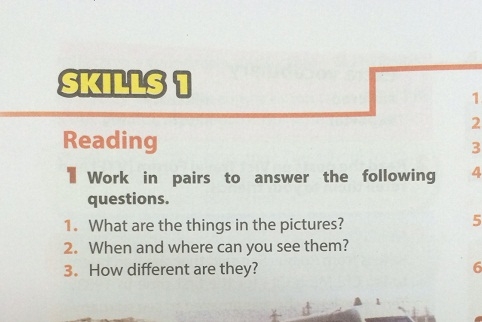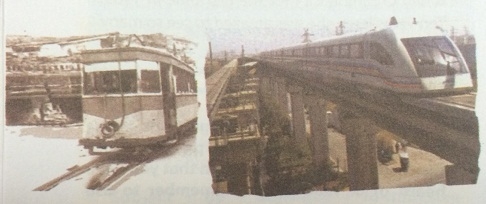Skills 1 Unit 6: Vietnam: Then and now
Skills 1 Unit 6: Vietnam: Then and now. Phần kỹ năng luyện tập cho bạn đọc hai kĩ năng đọc và nói. Bài viết dưới đây cung cấp những gợi ý cũng như hướng dẫn giải bài tập trong sách giáo khoa.

Reading
1. Work in pairs to answer the following questions.
Làm việc theo cặp rồi trả lời câu hỏi sau:

- 1. What are the things in the pictures? các đồ vật trong bức ảnh là gì?
The first picture shows an old tram. The second picture shows a modern train.
- 2. When and where can you see them? Bạn có thể thấy chúng khi nào và ở đâu?
The tram would have been seen in a town or city. These trains can be seen nowadays in big, modern cities.
- 3. How different are they? Chúng trông khác như thế nào?
They are different in many ways:
- The first has fewer compartments (two or three) than the second (four).
- The first runs much more slowly.
- The first is not air-conditioned while the second is.
- The first runs along tracks on the ground at street level, while the second runs on elevated tracks.
- The first is powered by overhead electricity wires, while the second runs on electromagnetics.
2. Now read the article from a travel magazine. Then answer the questions that follow.
Bây giờ đọc bài báo ở tạp chí du lcihj. Sau đó trả lời câu hỏi sau.
THE TRAM SYSTEM IN HA NOI: THEN AND NOW
Ha Noi had its first tramways in 1900. The tram system was a major means of transport in the city for nine decades and thus the image of the tram and its clanging sounds have gone deep into the hearts and minds of Hanoians. Since it was convenient and cheap to get around the city and to the suburban areas by tram, the system was very popular. However, due to the population boom and the need for a under road system, the last rail track was removed.
Now, after more than 20 years, the population of Ha Noi has risen from about tivo million people to more than six million people; therefore, the number of vehicles on the roads has increased dramatically. To meet the increasing travel demands, Ha Noi is launching its first sky train system, connecting Cat Linh and Ha Dong. The system is expected to begin operations by 2016, with initial four-compartment skytrains. Furthermore, a new rail system project including around eight kilometres of skytrain rail and four kilometres of subway rail, connecting Ha Noi Central Station and Nhon, has also been under construction and is expected to be completed in a few years.
- 1. In which century was the tram system built?
In the 20th century
- 2. What was the role of the tram system in Ha Noi
It was a major means of transport for Hanoians.
- 3. When was the system removed?
In 1990
- 4. What has happened to Ha Noi's population over the last two decades?
The population has increased dramatically
- 5. How has the tram system in Ha Noi been improved recently?
New rail systems including a skytrain and a subway are under way.
- 6. Which of the transport systems do you think : more impressive to Hanoians?
I think is the BRT in Hanoi
3. Decide if the following statements are true (T) or false (F).
Xem những câu sau là đúng (T) hay sai (F)
- 1. The purpose of the passage is to persuac-e people to go by skytrain. F
- 2. Hanoians were deeply attached to their trar system. T
- 3. The tram system of Ha Noi only operated in thr downtown area. F
- 4. There has been a sharp increase in the number of vehicles in Ha Noi. T
- 5. The new skytrain has been running for two years. F
4. Work in pairs. List different types of traditional and modern transport systems in Viet Nam.
Làm việc theo cặp. Liệt kê các loại phương tiện giao thông truyền thống và hiện đại ở Việt Nam.
Past | road types: path, earthen road, trench, brick road, tunnel, alley, tram system vehicles: bicycle, rickshaw, coach, train, tram |
Present | road types: underpass, flyover, skytrain system, sky walk system, cable car, tunnel, alley vehicles: motorbike, bicycle, coach, train, car, tram, plane |
5. Discuss the changes in transport in your neighbourhood. Is there anything that you prefer about the traditional/modem transport systems where you live?
Thảo luận những thay đổi trong giao thông ở vùng xung quanh bạn. Có điều gì bạn thích hơn ở giao thông truyền thống hoặc hiện đại nơi bạn sống không?
Giải bài tập những môn khác
Môn học lớp 9 KNTT
5 phút giải toán 9 KNTT
5 phút soạn bài văn 9 KNTT
Văn mẫu 9 kết nối tri thức
5 phút giải KHTN 9 KNTT
5 phút giải lịch sử 9 KNTT
5 phút giải địa lí 9 KNTT
5 phút giải hướng nghiệp 9 KNTT
5 phút giải lắp mạng điện 9 KNTT
5 phút giải trồng trọt 9 KNTT
5 phút giải CN thực phẩm 9 KNTT
5 phút giải tin học 9 KNTT
5 phút giải GDCD 9 KNTT
5 phút giải HĐTN 9 KNTT
Môn học lớp 9 CTST
5 phút giải toán 9 CTST
5 phút soạn bài văn 9 CTST
Văn mẫu 9 chân trời sáng tạo
5 phút giải KHTN 9 CTST
5 phút giải lịch sử 9 CTST
5 phút giải địa lí 9 CTST
5 phút giải hướng nghiệp 9 CTST
5 phút giải lắp mạng điện 9 CTST
5 phút giải cắt may 9 CTST
5 phút giải nông nghiệp 9 CTST
5 phút giải tin học 9 CTST
5 phút giải GDCD 9 CTST
5 phút giải HĐTN 9 bản 1 CTST
5 phút giải HĐTN 9 bản 2 CTST
Môn học lớp 9 cánh diều
5 phút giải toán 9 CD
5 phút soạn bài văn 9 CD
Văn mẫu 9 cánh diều
5 phút giải KHTN 9 CD
5 phút giải lịch sử 9 CD
5 phút giải địa lí 9 CD
5 phút giải hướng nghiệp 9 CD
5 phút giải lắp mạng điện 9 CD
5 phút giải trồng trọt 9 CD
5 phút giải CN thực phẩm 9 CD
5 phút giải tin học 9 CD
5 phút giải GDCD 9 CD
5 phút giải HĐTN 9 CD
Trắc nghiệm 9 Kết nối tri thức
Trắc nghiệm 9 Chân trời sáng tạo
Trắc nghiệm 9 Cánh diều
Tài liệu lớp 9
Văn mẫu lớp 9
Đề thi lên 10 Toán
Đề thi môn Hóa 9
Đề thi môn Địa lớp 9
Đề thi môn vật lí 9
Tập bản đồ địa lí 9
Ôn toán 9 lên 10
Ôn Ngữ văn 9 lên 10
Ôn Tiếng Anh 9 lên 10
Đề thi lên 10 chuyên Toán
Chuyên đề ôn tập Hóa 9
Chuyên đề ôn tập Sử lớp 9
Chuyên đề toán 9
Chuyên đề Địa Lý 9
Phát triển năng lực toán 9 tập 1
Bài tập phát triển năng lực toán 9

Bình luận